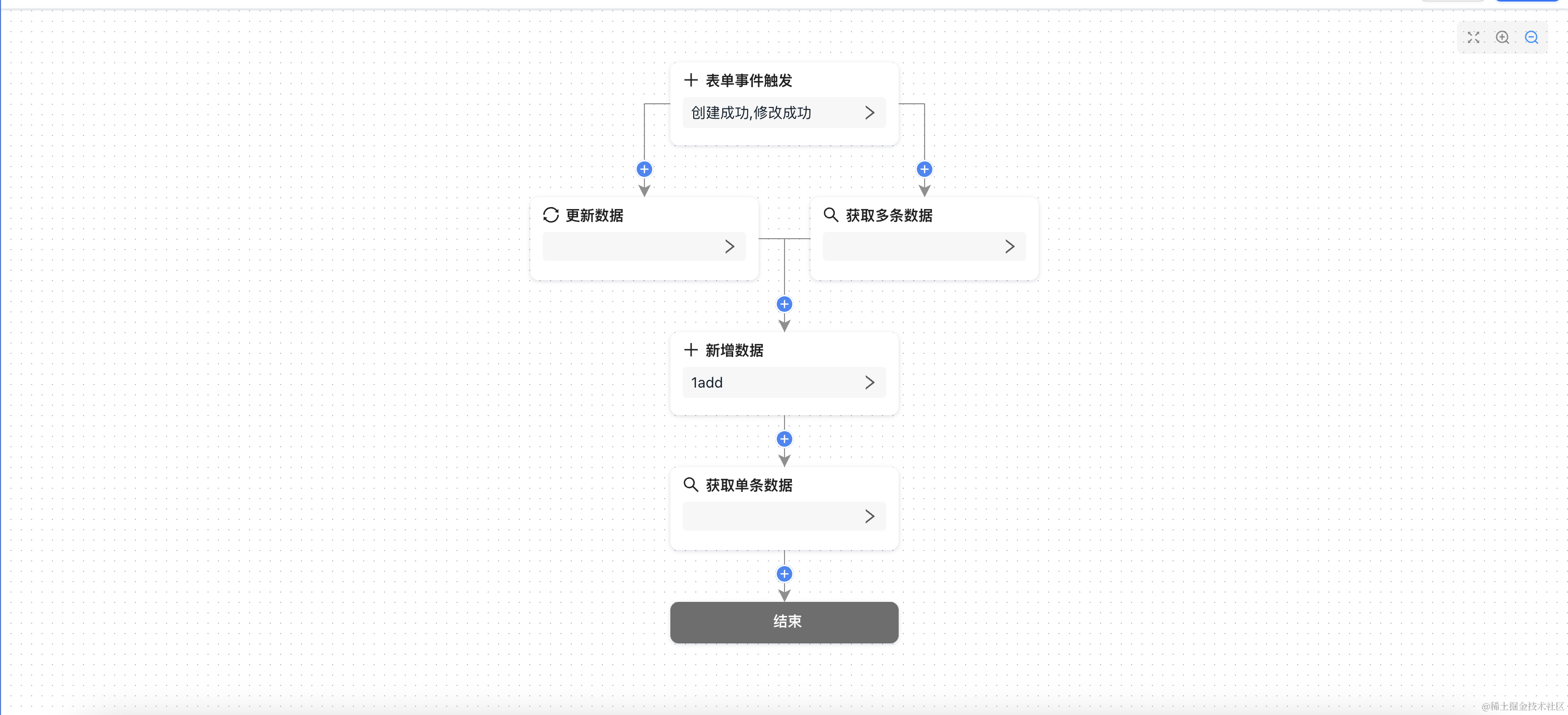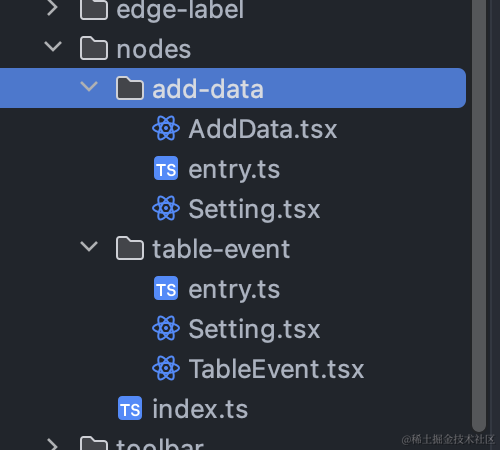前沿
上一篇我们介绍了开源的无代码开发平台Brick, 在无代码开发中比较常见的一个功能是工作流设计器,工作流可以做流程审批设计,数据操作设计等。我们基于antv的x6
封装一个通用的能力,剩下的只需扩充节点类型就可以。
演示


设计分析
我们看上面的演示功能,主要有三个核心模块。
- 工作流画布(Workflow)
- node节点设置 (NodeSetting)
- node节点显示 (Node)
工作流画布
画布初始化
- 初始化工作流,为了方便统一管理,我们使用一个自定义hooks去管理画布的初始化.
export const useWorkflowInit = (container: React.RefObject<HTMLDivElement>) => {
const currGraphRef = useRef<Graph>();
const update = useUpdate();
useEffect(() => {
const graph = new Graph({
container: container.current,
autoResize: true, //自动变更画布大小
grid: true,
panning: false, //可以拖拽画布
// mousewheel: true, //滚轮缩放画布
background: {
},
connecting: {},
onEdgeLabelRendered: (args: any) => {
const { selectors, edge } = args;
const content = selectors.foContent as HTMLDivElement;
if (content) {
ReactDOM.render(<EdgeLabel edge={edge} />, content);
}
},
});
setWorkflowElement(container.current);
}, [container.current]);
return {
graph: currGraphRef.current,
};
};
- 使用hooks做初始化
export const Workflow: FC<IWorkflowProps> = ({ style, className, data }) => {
const { graph } = useWorkflowInit(containerRef);
return (
<div style={style} className={classNameStr}>
<div ref={containerRef} className={s.container} id="container"></div>
</div>
);
};
全局数据管理
- 我们使用context做数据管理,方便我们在组件内去使用相关信息和操作的相关功能等。
export class WorkflowAppProcessor {
self: WorkflowAppProcessor;
graphProcessor: GraphProcessor;
workflowElement: HTMLElement | null;
/**
* node 节点相关内容
*/
nodeModule: TNodeModuleMap;
//工作留数据
workflowData: Observable<IWorkflowEntity>;
activeNode: Observable<IWorkflowNodeData | null>;
constructor() {
this.self = this;
this.activeNode = observable(null);
this.workflowData = observable({} as IWorkflowEntity);
this.workflowElement = null;
this.graphProcessor = createGraphProcessor().processor;
this.nodeModule = getNodeModule();
}
setWorkflowElement = (element: HTMLDivElement) => {
this.workflowElement = element;
};
/**
* 设置workflow数据
* @param data
*/
setWorkflowData = (data: IWorkflowEntity) => {
this.workflowData.set(data);
};
/**
* 根据类型获取节点的默认数据
* @param nodeType
* @param defaultNodeData
*/
_getDefaultNodeData = (nodeType: TNodeType, defaultNodeData?: Partial<IWorkflowNodeData>) => {
};
addNodeData = (nodeType: TNodeType, defaultNodeData?: Partial<IWorkflowNodeData>) => {
};
/**
* 修改node data
* @param nodeData
*/
updateNodeData = (nodeData: IWorkflowNodeData) => {
...
};
....
}
node节点和setting
我们看到节点类型会有很多,我们可以按照约定去注册使用节点。
注册
- 我们用两个类型举例
看下面的截图,为每个类型分别创建了三个文件。
entry.ts入口文件Setting.tsx节点设置器AddData.tsx ...节点显示组件

entry.ts入口文件功能
export class AddDataNode extends BaseNode {
// 获取节点显示组件
static getNodeElement = (): TLazyFunctionComponent => {
return React.lazy(() => import('./AddData'));
};
// 获取节点设计组件
static getSettingPanel = (): TLazyFunctionComponent => {
return React.lazy(() => import('./Setting'));
};
// 元数据信息
static getMetadata = (): ISettingPanelMetaData => {
return {
name: '新增数据',
type: ENodeType.AddData,
icon: React.createElement(PlusOutlined),
};
};
// 默认配置数据
static getDefaultConfigData = () => {
return {} as IAddDataNodeConfig;
};
}
看到 AddDataNode继承了BaseNode,我们可以在BaseNode去做实现约束。在入口文件中的getNodeElement和getSettingPanel方法中使用了React.lazy,可以帮我们实现异步加载这些组件。
Setting.tsx节点设置器
在Setting中封装一个SettingFormItem,是对antd的FormItem做了封装,提供设置的变更
const Setting: FC<ISettingComponentProps<ENodeType.AddData>> = (props) => {
const { nodeData } = props;
return (
<div>
<SettingFormItem
title={'选择表单'}
formItemProps={{
name: ['tableId'],
}}
>
<AppTableCaseCadeSelect />
</SettingFormItem>
</div>
);
};
export default Setting;
- 节点显示组件
通过props传递nodeData,可以方便的获取节点的数据来做显示
const TableEvent: FC<INodeComponentProps<ENodeType.TableEvent>> = (props) => {
const { nodeData } = props;
const triggerEvent = nodeData?.config?.triggerEvent;
....
return <div>{text}</div>;
};
export default TableEvent;
- 获取节点信息,存储到全局对象中
import * as nodes from '../components/nodes';
export const getNodeModule = () => {
const result: TNodeModuleMap = {} as TNodeModuleMap;
Object.values(nodes).forEach((item) => {
const metaData = item.getMetadata();
const nodeType = metaData.type;
const nodeModuleValue: INodeModuleValue = {
nodeComponent: item.getNodeElement(),
settingComponent: item.getSettingPanel(),
metaData,
defaultNodeConfigData: item.getDefaultConfigData?.() || {},
};
result[nodeType] = nodeModuleValue;
});
return result;
};
Setting和Node容器
- SettingContainer
主要从头全局状态中获取当前选中的node节点,根据节点的node类型去做对应的Setting展示。集成了antd的form组件,从而点确定的时候去更新全局需要存储的信息。
export interface ISettingContainerProps {}
export const SettingContainer: FC<ISettingContainerProps> = memo((props) => {
const [activeNode, clearActiveNode, nodeModule, updateNodeData, nodeMap] = useWorkflowAppSelector(
(s) => [s.activeNode, s.clearActiveNode, s.nodeModule, s.updateNodeData, s.workflowData.nodeMap]
);
const nodeId = activeNode?.id!;
const [form] = Form.useForm();
useEffect(() => {
const values = nodeMap?.[nodeId] || {};
form.setFieldsValue(values);
}, [nodeId]);
const onClose = useMemoizedFn(() => {
clearActiveNode();
});
/**
* 更新widget
*/
const onOk = async () => {
try {
const values = await form.validateFields();
updateNodeData({ ...values, id: nodeId });
onClose();
} catch (error: any) {
const errMessage = error?.errorFields?.[0]?.errors?.[0];
message.error(errMessage);
return;
}
};
const SettingComponent = nodeModule?.[activeNode?.type!]?.settingComponent;
const Footer = () => {
return (
<div className={s.footer}>
<Space>
<Button onClick={onClose}>取消</Button>
<Button type={'primary'} onClick={onOk}>
确定
</Button>
</Space>
</div>
);
};
return (
<Drawer
title={activeNode?.name || '设置'}
placement="right"
bodyStyle={{
padding: '24px 0',
}}
width={600}
onClose={onClose}
open={Boolean(activeNode)}
footer={<Footer />}
>
<Form form={form}>
<Suspense fallback={<div>Loading...</div>}>
{SettingComponent && <SettingComponent nodeData={activeNode!} />}
</Suspense>
</Form>
</Drawer>
);
});
- NodeContainer
主要也是通过当前激活的节点,去做对应的容器渲染。
export const NodeContainer = ({ node }: { node: Node }) => {
const NodeComponent = nodeModule?.[nodeType]?.nodeComponent;
return (
<div
onClick={onNodeClick}
>
{!isEnd && (
<div className={s.content}>
<div className={s.left}>{NodeComponent && <NodeComponent nodeData={currNode!} />}</div>
</div>
)}
</div>
);
};
通过以上的设置,后续我们扩充节点只需要添加这三个文件就可以了。
画布操作
画布内的节点,连线等操作,我们封装一个通用的类来管理。
export class GraphProcessor extends BaseProcessor {
// graph实例,不是
graph: Graph | null;
constructor() {
super();
this.graph = null;
this.init();
}
private init = async () => {
this.listeners();
};
/**
* 设置graph实例
* @param graph
*/
setGraph = (graph: Graph) => {
this.graph = graph;
// @ts-ignore
window._graph = graph;
};
/**
* 添加node节点
* @param nodeType
* @param data
*/
addNode = (nodeType: TNodeType, data: Node.Metadata) => {
data.data = {
...data.data,
type: nodeType,
};
if (!data.id) {
data.id = uuid();
}
return this.graph?.addNode({ ...DEFAULT_NODE_ATTR, ...data });
};
addEdge = (source: string, target: string) => {
return this.graph?.addEdge({
source,
target,
attrs: {
line: {
stroke: '#8f8f8f',
strokeWidth: 1,
},
},
defaultLabel: {
markup: Markup.getForeignObjectMarkup(),
attrs: {
fo: {
width: 18,
height: 18,
x: -9,
y: 0,
// y: -(NODE_GAP / 2),
},
},
},
label: {
// attrs: {
// text: {
// text: "s1"
// }
// },
position: {
distance: -35,
// distance: -(NODE_GAP / 2)
},
},
router: {
name: 'orth',
args: {
padding: {
bottom: 10,
},
},
},
});
};
addNodeByEdge = ({
nodeType,
data,
edge,
isRedraw = true,
}: {
nodeType: TNodeType;
data?: Node.Metadata;
edge: Edge;
isRedraw?: boolean;
}) => {
const sourceId = edge.getSourceCellId();
const targetId = edge.getTargetCellId();
this.addNode(nodeType, data!);
// 当前线删除
edge.remove();
this.addEdge(sourceId, data!.id!);
this.addEdge(data!.id!, targetId);
if (isRedraw) {
this.redraw();
}
};
/**
* 重新绘制实图
*/
redraw = () => {
const nodes = this.graph?.getNodes();
const edges = this.graph?.getEdges();
const graphArea = this.graph?.getGraphArea();
// 画布宽度
const graphWidth = graphArea?.width || 0;
// 画布高度
const graphHeight = graphArea?.height || 0;
const connections =
edges?.map((f) => ({
sourceId: f.getSourceCellId(),
targetId: f.getTargetCellId(),
})) || [];
// 1. 通过edges找出层级关系
const treeLevelData = convertToLevelTree(connections);
treeLevelData.forEach((currLevelData, level) => {
// 当前级别数量
const currLevenLength = currLevelData.length;
// 当前级别node总宽度
const nodeSumWidth = NODE_WIDTH * currLevenLength + NODE_GAP * (currLevenLength - 1);
const currBeginX = (graphWidth - nodeSumWidth) / 2;
currLevelData.forEach((nodeId, index) => {
const currNode = this.graph?.getCellById(nodeId) as Node;
if (currNode) {
// const { width, height } = currNode.getSize();;
currNode?.setPosition({
x: currBeginX + (NODE_WIDTH + NODE_GAP) * index,
y: NODE_GAP + (NODE_HEIGHT + NODE_GAP) * level,
});
}
});
});
// 2. 根据层级关系重新渲染
};
/**
* 删除node节点
* @param node
*/
removeNode = (node: Node) => {
this.graph?.removeNode(node);
};
/**
* 获取workflow数据
*/
getData = () => {
return this.graph?.toJSON();
};
}
其中的一些细节就不做详细介绍了,有需要的可以直接看代码。
联系我
建立了一个微信交流群,请添加微信号brickmaster1,备注brick,我会拉你进群
总结
整个工作流的代码在 b-workflow,有需要的,可以直接去查看
大家觉得有帮助,请在github帮忙star一下。
如果你觉得该文章不错,不妨
1、点赞,让更多的人也能看到这篇内容
2、关注我,让我们成为长期关系
3、关注公众号「前端有话说」,里面已有多篇原创文章,和开发工具,欢迎各位的关注,第一时间阅读我的文章






















 236
236











 被折叠的 条评论
为什么被折叠?
被折叠的 条评论
为什么被折叠?








